Introduction: Community and Its Resources
- community: New Orleans.
- resources:
- the Office of Emergency Preparedness.
- community warning system.
- storm shelters (“Hurricanes,” n.d.).
- emergency text messages from the City of New Orleans (“Hurricane preparedness,” n.d.).
- 17 evacuspots.
- special needs registry.
- city-assisted evacuation (“Hurricanes & tropical weather,” n.d.).
The City of New Orleans is at high risk of hurricanes, so there are many community resources available. After the devastating category 5 Hurricane Katrina, which led to catastrophic damage to the city in 2005, some new safety measures and response activities were introduced (Schneider, 2015). There are many options for citizens to stay informed about dangerous changes in weather. For citizens that cannot reach evacuspots, there is a register where they can request additional assistance.
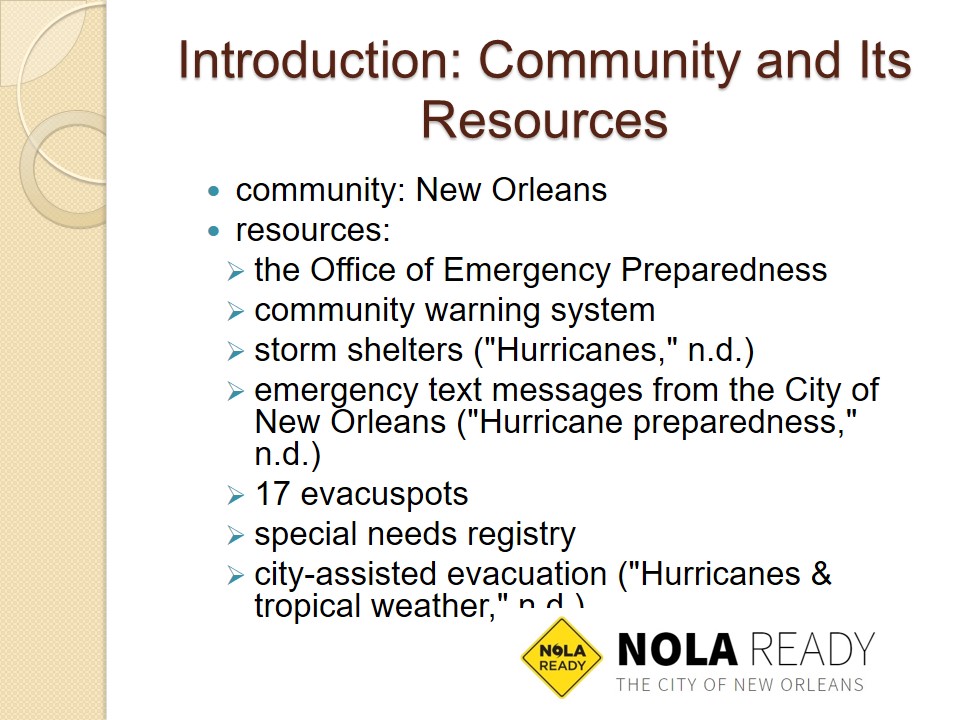
The Roles of Community Organizations and the Needs They Will Fulfill
- Informing citizens;
- arranging evacuation;
- helping people and pets;
- providing shelter and food;
- arranging the safe return of people after the situation is stabilized.
The major function of community resources is informing the people living in New Orleans about upcoming storms and hurricanes. By doing so, the citizens’ need for staying aware of the situation will be fulfilled. The next highly important duty of community organizations is arranging the evacuation of people and pets. These measures are taken in accordance with such statutes as the Post-Katrina Emergency Management Reform Act of 2006 and the Pets Evacuation and Transportation Standards Act of 2006 (Haddow, Bullock, & Coppola, 2014). Another role of community organizations is providing people with necessary hygienic items, food, and shelter for the period of evacuation. This function fulfills the basic physical needs of citizens and their pets. Finally, local organizations are responsible for the return of citizens to their homes after the hurricane or for building new homes for them in case their houses have been destroyed.
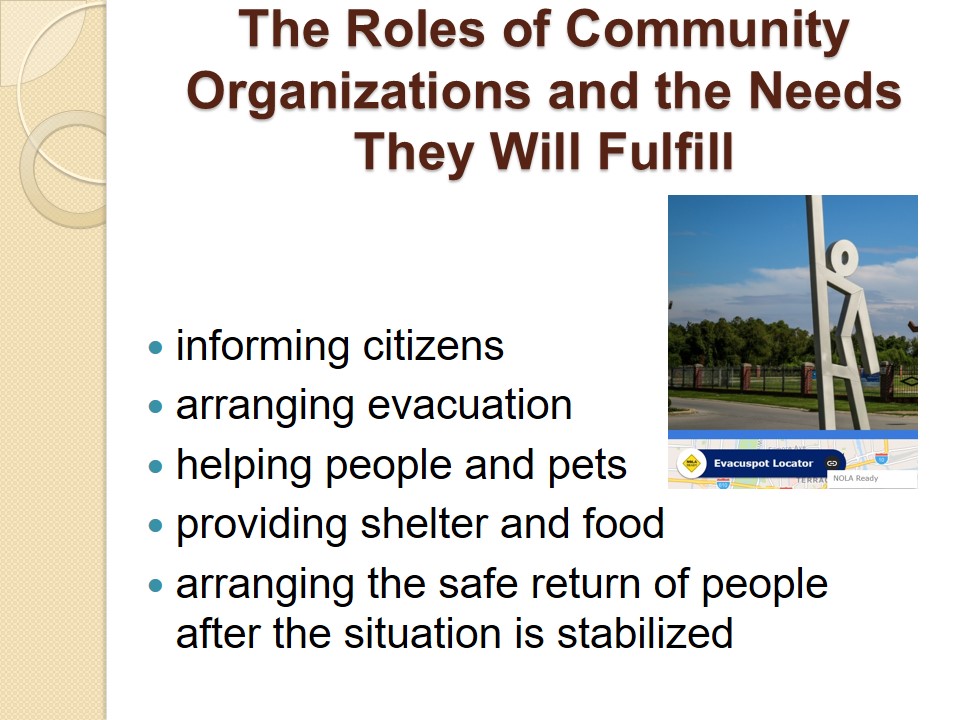
How Community Organizations Will Respond to the Hurricane
- send emergency text messages;
- inform on the radio and TV;
- announce the evacuation;
- arrange assisted evacuation for immobile citizens and other vulnerable populations;
- organize the appropriate coordination between infrastructure organizations;
- address neighboring cities, state organizations, and the federal government for help.
The response to a disaster is the third phase in the emergency management structure, the first two being mitigation and preparedness, and the last one being recovery (Edwards, 2014). The main role in the process of response belongs to community resources since they are the closest to the disaster area. The primary response to the hurricane is making sure that all citizens are aware of the situation. The next immediate step to be taken is evacuating people from dangerous zones. Also, it is necessary to take into consideration whose citizens who are on the special needs registry. Further, community organizations have to arrange the effective coordination of various infrastructure organizations, as well as contact the neighboring cities and state and federal organizations.
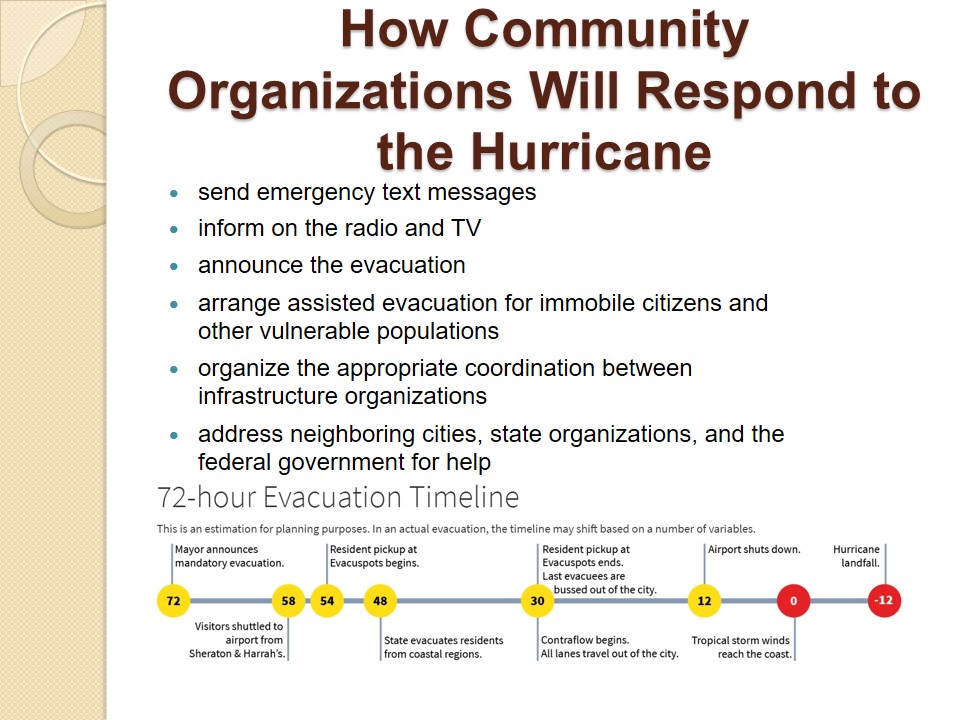
Infrastructure Organizations
- 504HealthNet.
- City of New Orleans Health Department.
- New Orleans Musicians Assistance Foundation.
- behavioral health.
- primary care.
- PACE Greater New Orleans (“Guide to community health,” 2012).
There is a variety of community health care options in New Orleans, including hospitals, clinics, mobile units, and health centers. These facilities’ functions are thoroughly described in the guideline titled 504HealthNet (“Guide to community health,” 2012). The mentioned centers deal with behavioral health, primary care, and child health (“Guide to community health,” 2012). Some of the largest community health centers are the Common Ground Health Clinic, the PACE Greater New Orleans, the New Orleans Musicians’ Clinic, and the New Orleans East Community Health Center (“Guide to community health,” 2012). Many clinics offer social services to their customers, which is particularly important in the event of a disaster. Apart from hospitals, there are mobile units available to citizens (“Guide to community health,” 2012). The diversity of infrastructure organizations allows concluding that in case of hurricane, people will receive the necessary healthcare help.
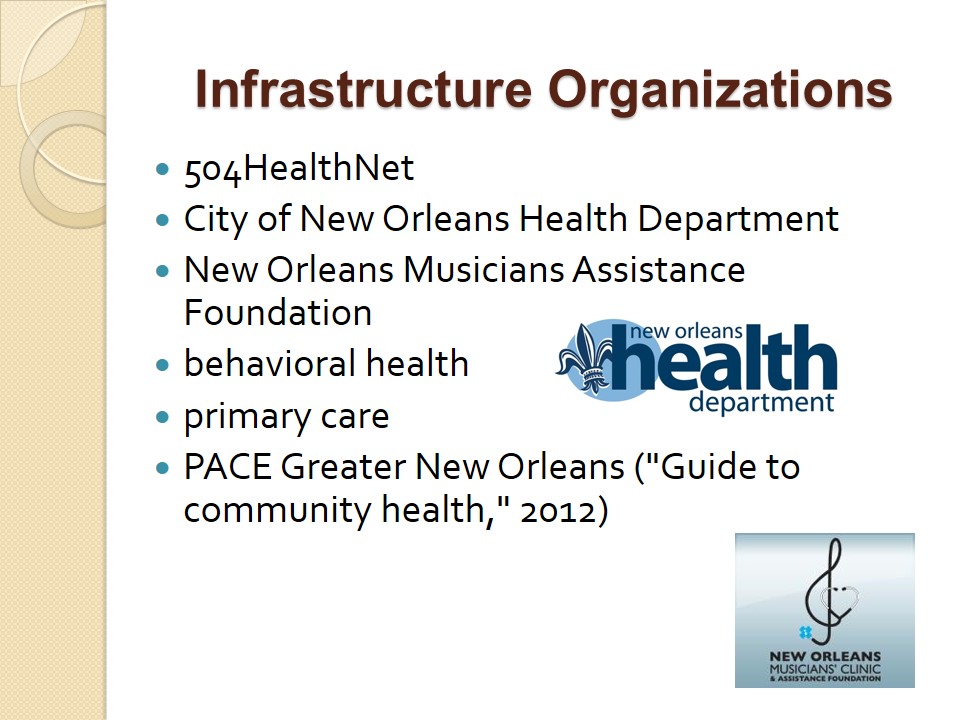
The Roles of Infrastructure Organizations and the Needs They Will Fulfill
- transporting victims to hospitals and centers;
- providing social support to citizens;
- performing first aid prior to taking people to hospitals;
- arranging the coordination between facilities and disaster areas (Graphics taken from “Guide to community health,” 2012).
Infrastructure organizations play an important role in case of disaster in some area. While community resources help to evacuate people from the most dangerous spots, it is the responsibility of hospitals and medical centers to provide survivors with the most appropriate and prompt medical help. When an emergency occurs, New Orleans hospitals and other facilities become centers of first aid to victims. Apart from helping citizens to cope with physical injuries, infrastructure organizations fulfill the need for social support. Besides, these facilities should arrange the collaboration within the healthcare system to provide the sufficient help to every individual.
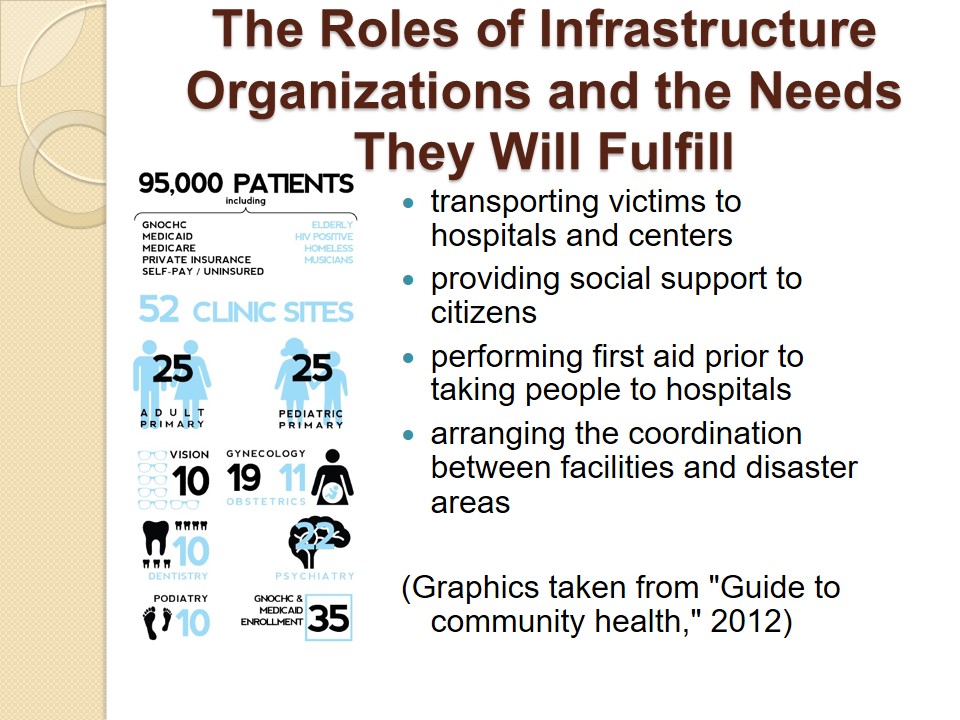
How Infrastructure Organizations Will Respond to the Hurricane
- receive the message from community resources;
- arrange transportation for survivors who suffered the most;
- prepare emergency rooms for patients;
- arrange social support specialists’ non-stop work.
In case of hurricane, the immediate response of infrastructure organizations will be receiving the information about disaster locations from community resources. After that, ambulances, helicopters, and other available types of transportation will be sent to collect survivors from the area of the disaster. Another important aspect of responding is the triage of people that is performed by healthcare specialists who have to operate quickly and calmly to make sure that those wounded most seriously are the first ones to receive help. Finally, upon locating people in hospitals and healthcare centers and giving them the necessary aid, infrastructure facilities will arrange social support for the survivors.
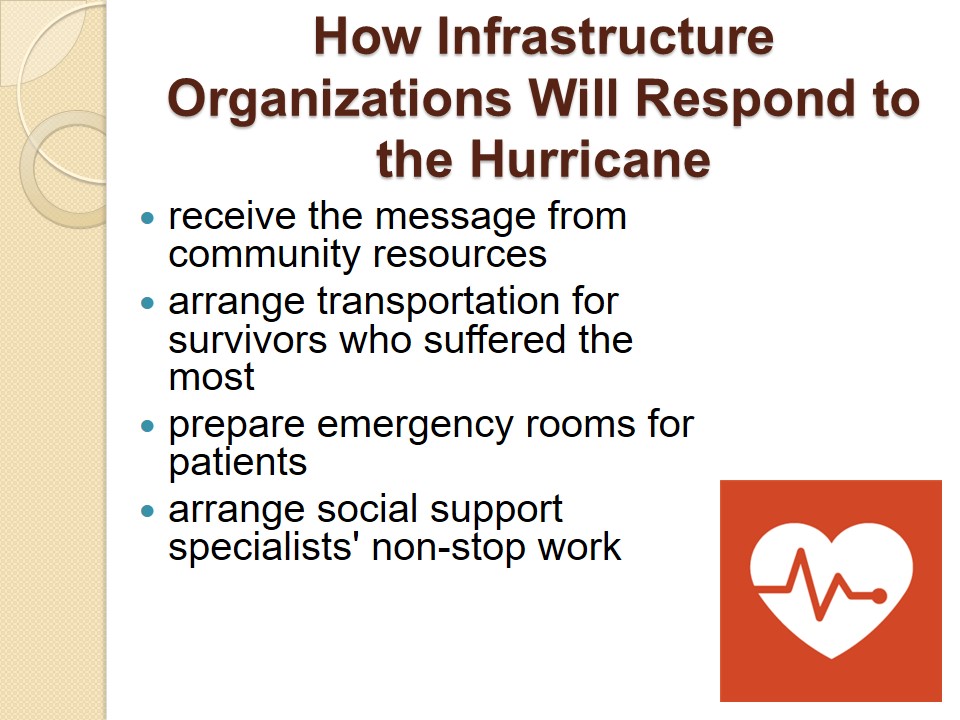
Private Sector Resources
- warehouses;
- private pharmacies;
- churches;
- private security firms.
Frequently, when a hurricane devastates some area, the efforts of public organizations may not be enough to control the situation and help the survivors. In such cases, the use of private sector resources may be needed, which is a part of the National Preparedness Goal (Edwards, 2014) and an essential component of the resilience process (Pfefferbaum, 2014). The issue of security is rather significant in the event of hurricane. In case public police forces cannot provide the sufficient safety of people’s homes, New Orleans Private Patrol Service (n.d.) can help. If additional shelters are needed, it is possible to locate survivors in the city’s churches. Private pharmacies and warehouses can be of use if the additional supply of medicines or food is required.
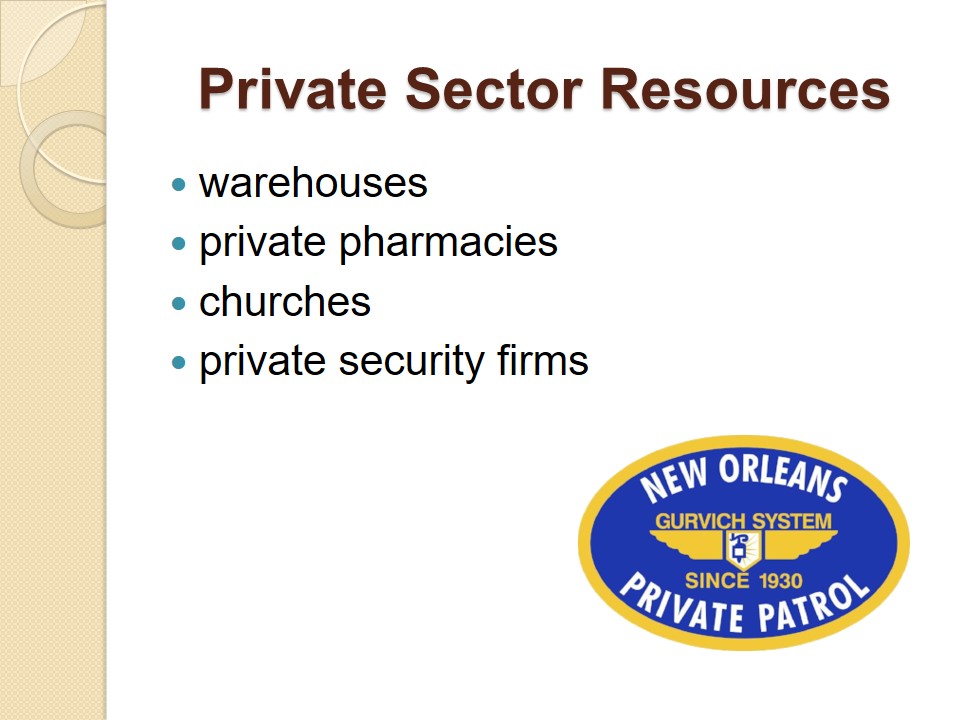
Assets Available Throughout Neighboring Cities
- Neighboring cities:
- Gretna;
- Meraux;
- Kenner;
- Poydras;
- Belle Chasse;
- Organizations:
- hospitals;
- hotels;
- churches;
- police forces.
For any location prone to hurricanes, it is crucial to have neighbors on which it can rely in case of emergency. The closest cities to New Orleans are Gretna, Meraux, Kenner, Poydras, and Belle Chasse. The 2005 Hurricane Katrina demonstrated bad preparedness of both the City of New Orleans and its neighbors to the disaster (Schneider, 2015). Thus, it is crucial to encourage the neighboring cities’ authorities to participate in the response measures. Nearby cities can offer such facilities as housing and healthcare, which are the most crucial in the event of hurricane. Also, social and security services can be of great help.

The Roles of Neighboring Cities’ Organizations and the Needs They Will Fulfill
- housing;
- healthcare;
- security;
- social support.
The roles of neighboring cities’ organizations do not differ much from those of local facilities. The primary functions are helping the survivors to receive the first aid and provide them with shelter. Apart from these duties, New Orleans’ neighbors can arrange the security of the city’s citizens for the period of their stay. Along with these kinds of help, people from New Orleans can be offered social support from specialists. The experience shows that neighboring cities are not always ready to welcome the people who have lost their homes and other belongings (Schneider, 2015). However, it is necessary for each city to realize that it is not secure from a disaster and that it should be ready to help its neighbors.
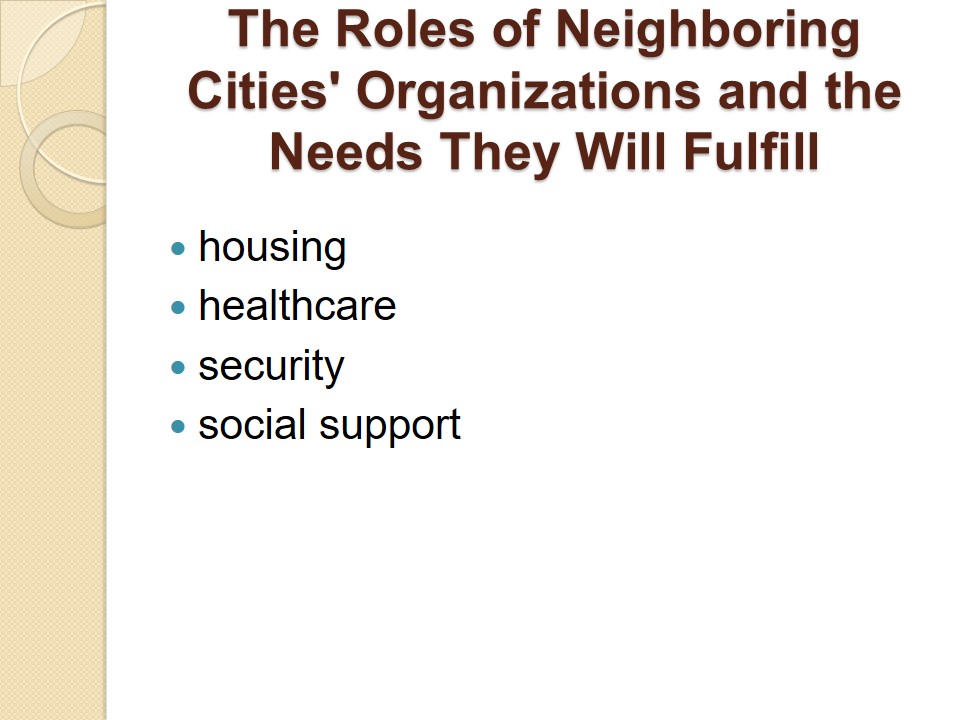
How the Neighboring Cities’ Organizations Will Respond to the Hurricane
- evaluate the situation;
- coordinate the response with one another;
- arrange transportation;
- provide shelter;
- offer medical services.
The primary response measure to be taken by neighboring cities is arranging the coordination between themselves to make sure that enough help is provided and that their efforts are distributed equally. Thus, the organizations of these locations need to contact New Orleans authorities and find out what kind of help is needed. Further, neighboring cities should design the scheme of transporting the survivors from New Orleans. Immediately after doing this, it is necessary to prepare shelter for the people who will be coming. For those of them who require additional medical or social support, the access to such services should be provided.
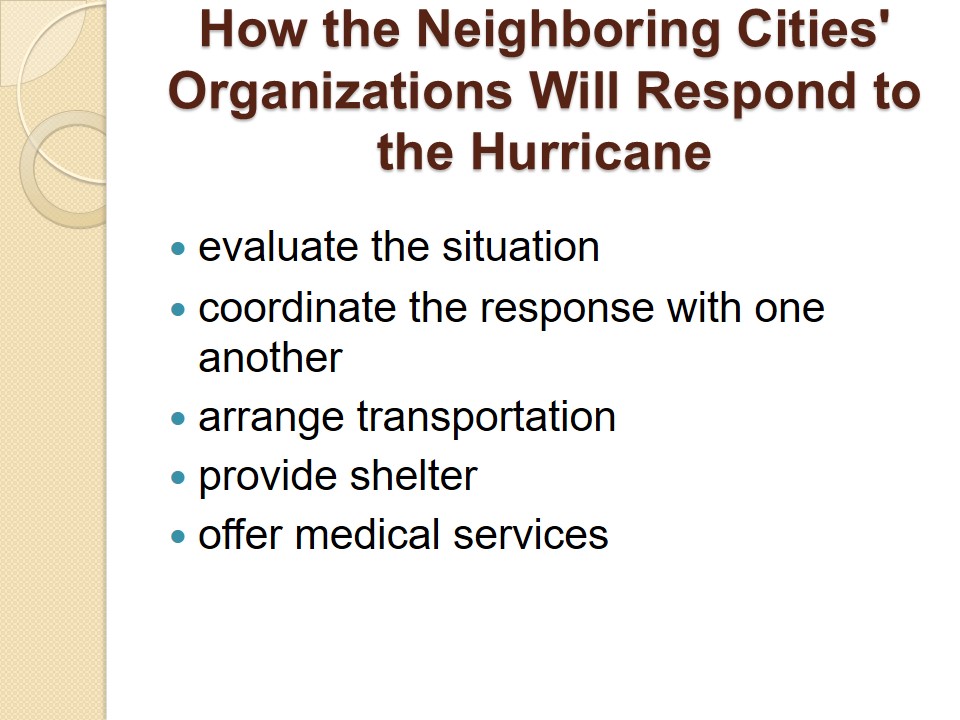
Resources Available in the County and State
- State of Louisiana Governor’s Office of Homeland Security and Emergency.
- American Red Cross.
- United Way for the Greater New Orleans Area.
- United Way for South Louisiana.
- United Way for Southwest Louisiana.
- Parish Office of Homeland Security and Emergency Preparedness.
New Orleans’s county and state resources are concerned with the State of Louisiana. There is a variety of organizations at this level that are engaged in emergency preparedness of the cities, including New Orleans (“Louisiana emergency preparedness guides,” 2018). The options available at these facilities are described in the Louisiana emergency preparedness guides that are frequently updated to provide citizens with the most relevant information.
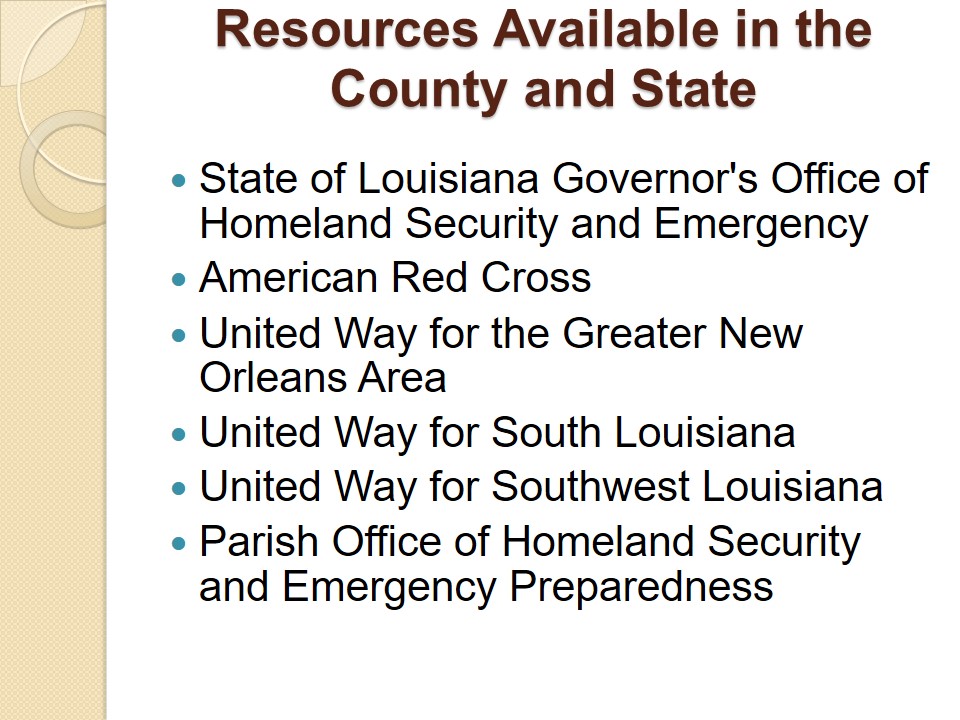
The Roles of County and State Organizations and How They Will Respond to the Hurricane
- family preparation;
- business preparation;
- evacuation;
- hazard mitigation;
- recovery.
The roles of county and state organizations are concerned with the constant updating of people about natural hazards and the ways of preparing for them. In particular, the “Louisiana emergency preparedness guide” (n.d.) is issued by the state to educate citizens about hurricanes and other disasters. The guide contains valuable data on personal and corporate preparation to storms as well as contact details of help centers. The response to the hurricane by county and state resources involves evacuation measures and recovery projects. Additionally, these organizations can provide medical help and social support.
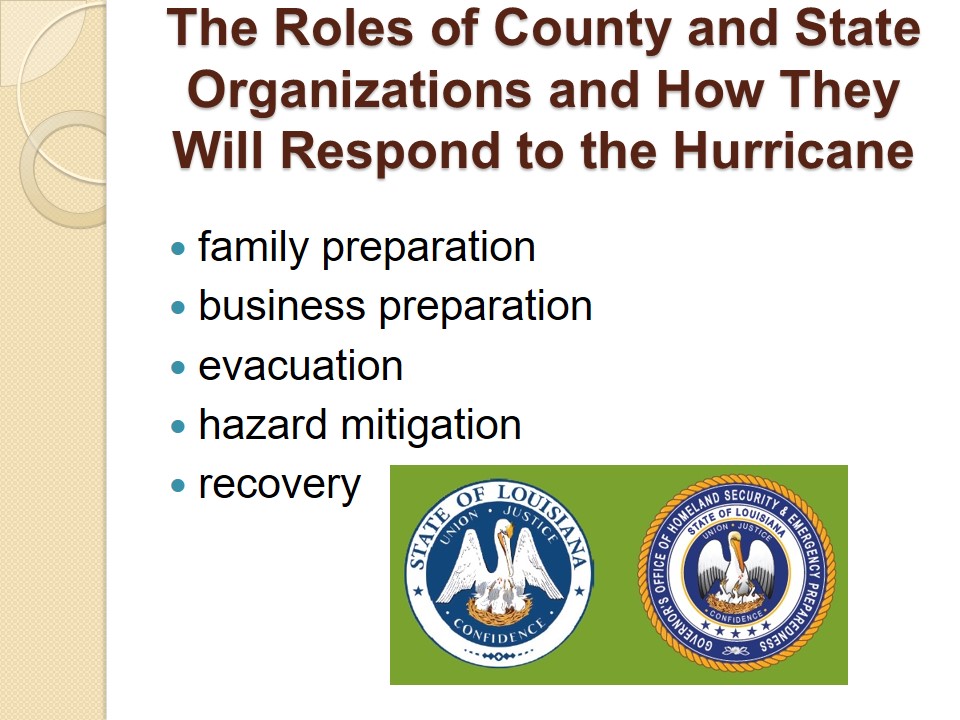
Assets Available in the Federal Government
- U.S. Department of Homeland Security (DHS):
- Federal Emergency Management Agency (FEMA):
- Office of Resilience;
- DHS Center for Faith-Based and Neighborhood Partnerships;
- Federal Insurance and Mitigation Administration;
- U.S. Fire Administration;
- Office of Equal Rights;
- Office of Response and Recovery;
- Mission Support (“U.S. Department of Homeland Security,” 2018).
- Federal Emergency Management Agency (FEMA):
The major federal-level organization dealing with hurricanes is FEMA, which is the element in the structure of the DHS. FEMA includes several offices, each of them managing a particular sphere of needs during a natural disaster. The most important branches of FEMA in case of hurricane are the Office of Resilience, the Office of Response and Recovery, the DHS Center for Faith-Based and Neighborhood Partnerships, and the Office of Equal Rights (“U.S. Department of Homeland Security,” 2018).
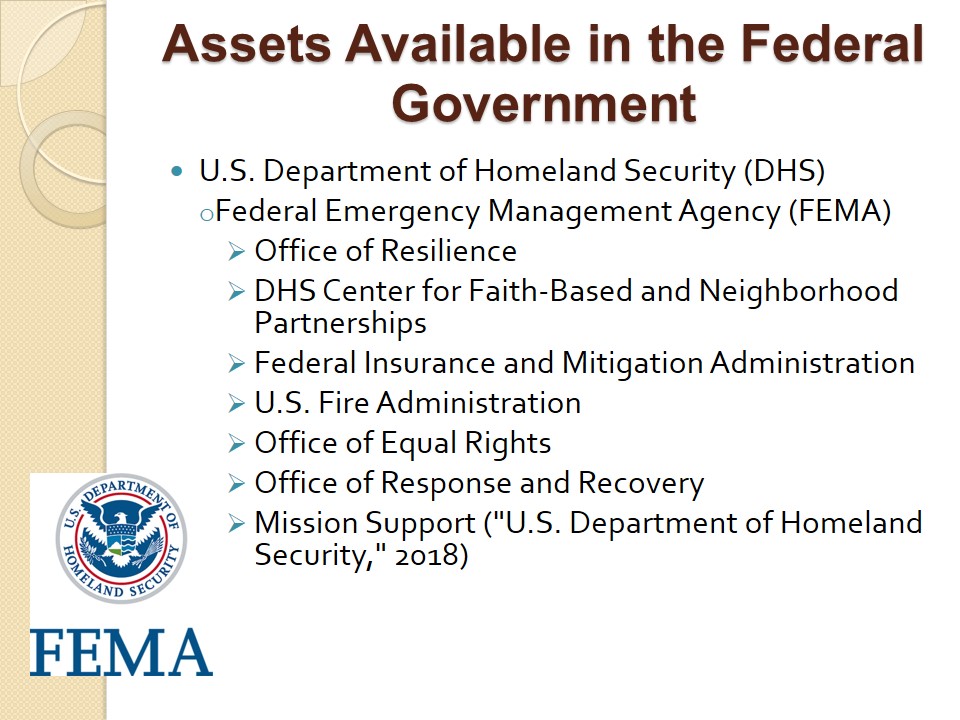
The Roles of the Federal Government, the Needs It Will Fulfill, and How It Will Respond to the Hurricane
- preparation;
- resilience;
- mitigation;
- response.
The organizations functioning at the government level are responsible for the citizens’ awareness of natural disasters and relevant preparation to them. FEMA has various offices, the branches of which operate in different states. The needs fulfilled by these resources are concerned with the proper housing and medical support after the hurricane. The response is performed in several steps, starting with the identification of the hurricane’s level and ending with the appropriate reaction to the situation.
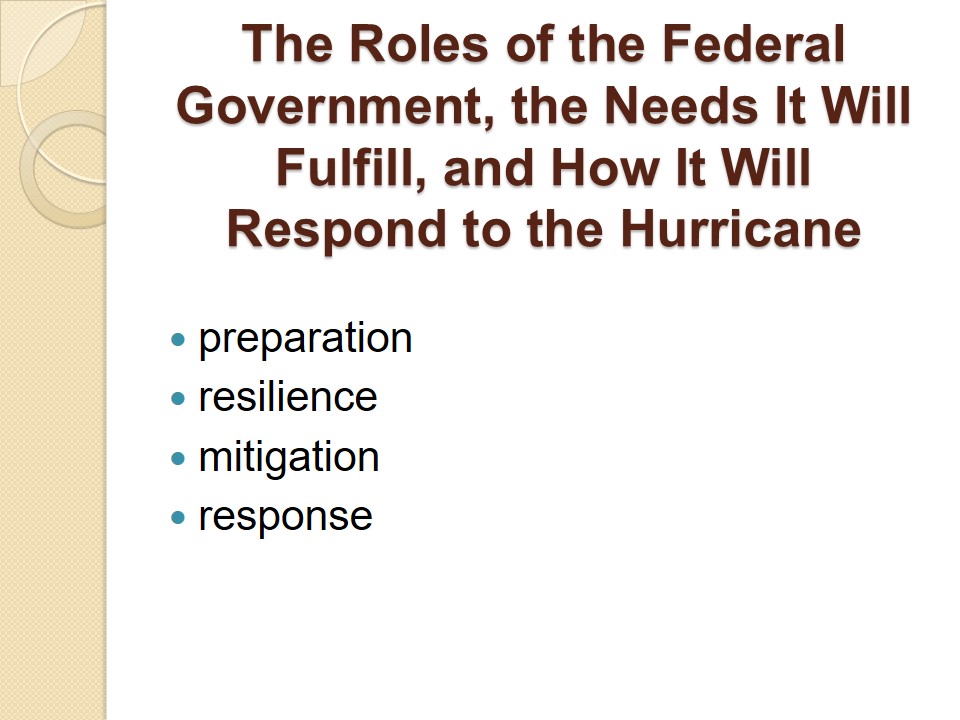
Conclusion and the Discussion of Resources’ Credibility
- Collaboration:
- community resources;
- infrastructure organizations;
- private sector resources;
- neighboring cities;
- county and state;
- federal government;
- Credibility of resources:
- books: academic sources;
- websites:
- created by the City of New Orleans, the State of Louisiana, and the Government.
- containing relevant data.
- published within the past five years (with the exception of one source).
The response of the organizations at each level both independently and in collaboration plays the significant role in the mitigation of the hurricane. The sources used in the preparation of the project are relevant and reliable. One source, “Guide to community health,” is dated by 2012, but it contains valuable data that could not be omitted in the presentation.
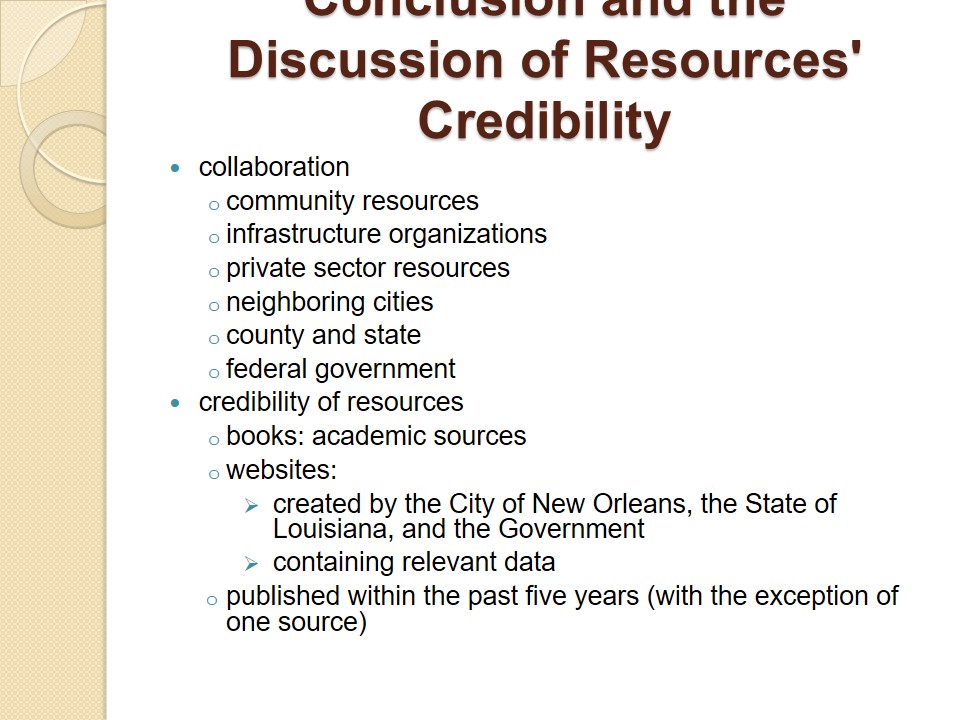
References
Edwards, F. L. (2014). Mitigation versus prevention: A view from the local government level. In A. Farazmand (Ed.), Crisis and emergency management: Theory and practice (2nd ed.) (pp. 675-689). Boca Raton, FL: CRC Press.
Guide to community health care in Greater New Orleans. (2012). Web.
Haddow, G. D., Bullock, J. A., & Coppola, D. P. (2014). Introduction to emergency management (5th ed.). Waltham, MA: Butterworth-Heinmann.
Hurricane preparedness. (n.d.). Web.
Hurricanes & tropical weather. (n.d.). Web.
Hurricanes. (n.d.). Web.
Louisiana emergency preparedness guide. (n.d.). Web.
Louisiana emergency preparedness guides. (2018). Web.
New Orleans Private Patrol Service. (n.d.). Web.
Pfefferbaum, R. L. (2014). Advancing community resilience to disasters: Considerations for theory, policy, and practice. In A. Farazmand (Ed.), Crisis and emergency management: Theory and practice (2nd ed.) (pp. 691-709). Boca Raton, FL: CRC Press.
Schneider, S. K. (2015). Dealing with disaster: Public management in crisis situations (2nd ed.). New York, NY: Routledge.
U.S. Department of Homeland Security/FEMA. (2018). Web.